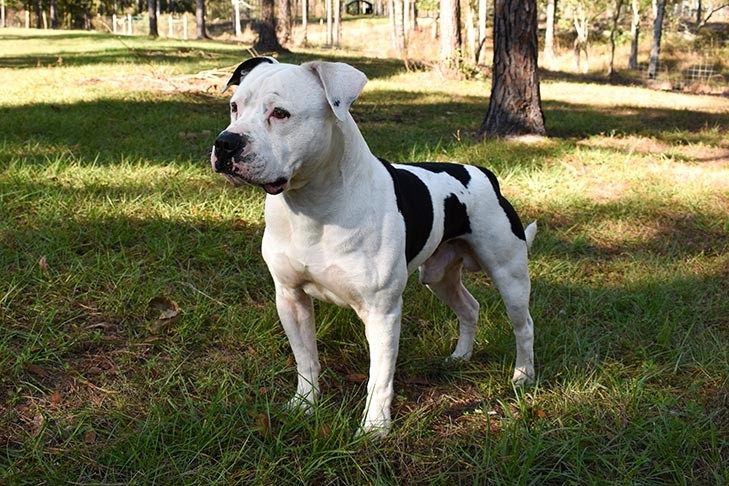
The Scott Type American Bulldog, developed by breeder Allen Scott, represents a distinctive variant of the American Bulldog breed characterized by its athletic build and enhanced agility. This type emerged from Scott's vision to create a more versatile working dog while maintaining the breed's core strengths. Distinguished by its longer legs, leaner frame, and more moderate features compared to the Johnson type, the Scott variant showcases a unique blend of performance-oriented traits. These bulldogs were specifically bred to excel in various tasks, from cattle handling to property protection, while retaining the breed's fundamental characteristics of strength and loyalty.
Scott Type American Bulldog
Physical Characteristics
The Scott type American Bulldog, developed by breeder Allen Scott, exhibits a distinct athletic build compared to other varieties. These dogs feature longer muzzles, more moderate stop and a less extreme undershot bite. They have a sleeker appearance with less bone mass and a more streamlined frame optimized for performance and agility. The Scott type tends to be lighter and more athletic in build than the Johnson type, though still muscular and powerful.
Performance Capabilities
The Scott type was specifically bred as a performance style, athletic dog with enhanced speed and agility. This variant excels at traditional working tasks like catching cattle and wild boar due to its more moderate build and athletic abilities. The Scott type demonstrates excellent stamina and athleticism while retaining the strength and determination characteristic of the breed. Their physical attributes make them particularly well-suited for agility work, catching activities, and tasks requiring sustained physical performance compared to other American Bulldog types.
Scott Type American Bulldog Physical Characteristics\nBreeding Philosophy and Working Heritage
Breeding Philosophy
While the previous sections covered physical traits and performance capabilities, this section focuses on Allen Scott's breeding methodology. Scott emphasized developing working dogs with versatility, agility, and intelligence. His breeding program specifically selected for functional traits that enhanced the dogs' ability to work with cattle and serve as catch dogs. Scott focused on maintaining the historical working abilities while improving athleticism and agility through selective breeding.
Working Heritage Applications
The Scott type's working heritage is deeply rooted in practical farm utility tasks. These dogs were specifically bred to excel at herding cattle, controlling feral hogs, and protecting property in the American South. Their athletic build and moderate structure made them particularly effective at tasks requiring sustained physical activity and quick movements. Scott type bulldogs inherited their working drive from the original English Bulldogs but were selectively bred to be more agile and versatile in their working roles. This careful breeding preserved the essential working traits while adapting them for modern agricultural needs.
Scott Type American Bulldog Breeding Program Development
Historical Evolution
While previous sections covered physical traits and working applications, this section examines the historical development of the Scott type. When Allen Scott joined John D. Johnson's breeding efforts to revive the American Bulldog breed, he specifically focused on preserving specimens from Southern farmers that exhibited more athletic builds. Scott's breeding program emerged as distinct from Johnson's by emphasizing performance capabilities over the heavier, more traditional bulldog appearance. This selective breeding approach helped establish what would become known as the Scott type or Standard type American Bulldog.
Genetic Influence
The Scott type's development involved careful genetic selection that differed from other American Bulldog breeding programs. While maintaining core bulldog traits, Scott's program incorporated genetics from working farm dogs that demonstrated superior agility and stamina. This genetic selection process focused on preserving the working ability and athletic performance rather than conforming to a specific physical appearance standard. The resulting Scott type bloodline became influential in developing performance-oriented American Bulldogs that excelled in practical working applications while maintaining sufficient strength and determination characteristic of the breed.
Conclusion
The Scott type American Bulldog represents a distinct variation of the breed that prioritizes athletic ability and working performance. Developed by breeder Allen Scott, these dogs feature a more moderate build with longer muzzles, less extreme features, and a sleeker frame compared to other varieties like the Johnson type. The breeding program specifically selected for functional traits that enhanced agility, stamina, and versatility while maintaining the breed's core strength and determination.
This research highlights how the Scott type's development was deeply rooted in practical agricultural applications, with these dogs bred to excel at tasks like cattle herding and wild boar catching. Scott's emphasis on working capabilities over conformational standards helped establish a performance-oriented bloodline that continues to influence the breed today. The success of this breeding philosophy demonstrates the importance of preserving working traits while adapting breeds to meet modern needs. These findings suggest that understanding the Scott type's distinct characteristics and breeding history is crucial for those interested in working-line American Bulldogs or performance-focused breeding programs.